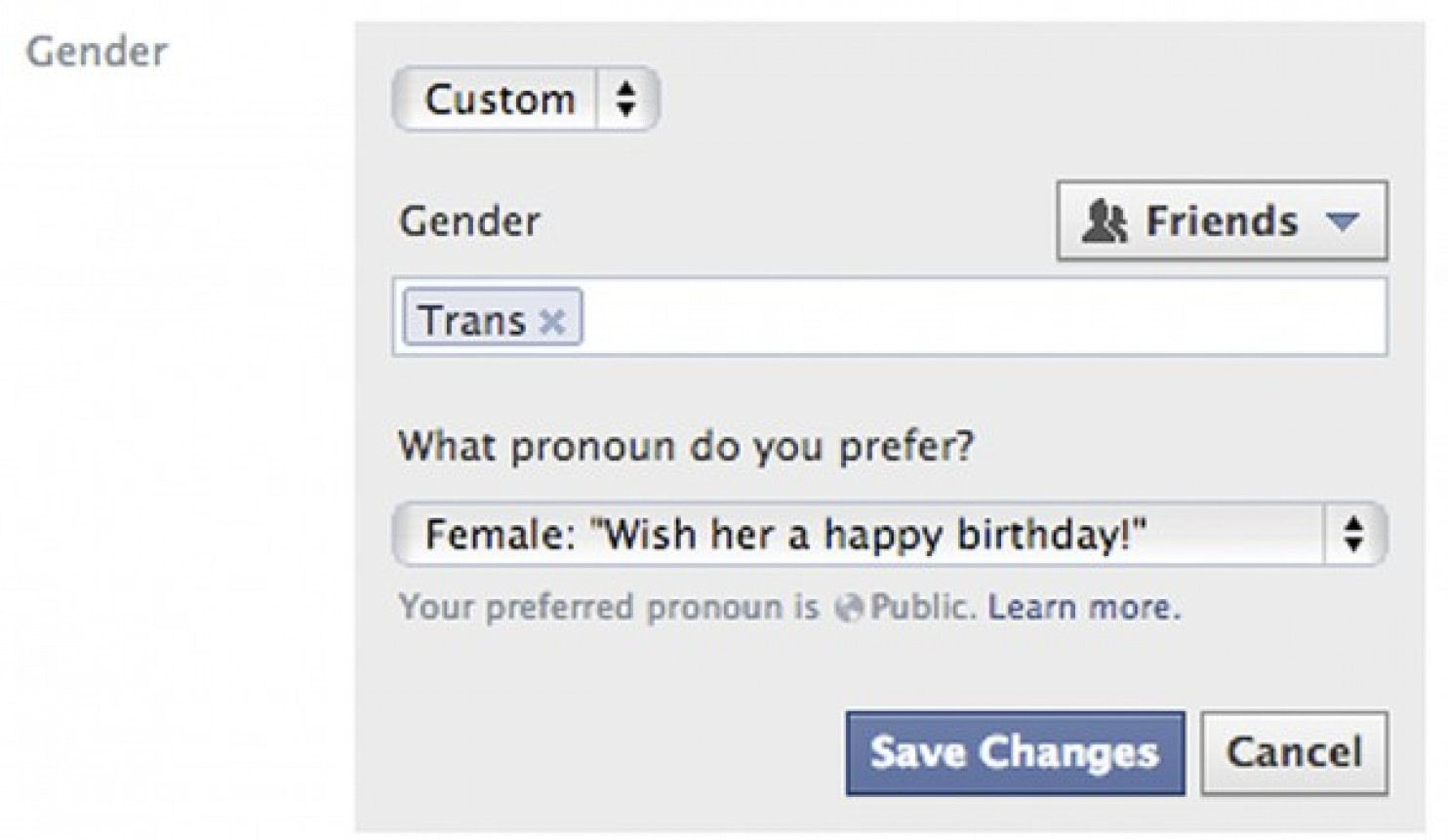Se Emne
|
Facebook’s gender options? Here’s what they mean!
|
|
| Dare2think |
Posted on 17-01-2015 03:08
|
|
Superadministrator  Indlæg: 335 Tilmeldt: 24.01.14 |
 Facebook software engineer Brielle Harrison, who identifies as a trans woman, demonstrates expanded options for gender identification at her company’s Menlo Park, Calif., headquarters. (AP Photo/Noah Berger) February 14, 2014 Facebook introduced new gender options yesterday, making the site more user-friendly to people who don’t identify strictly as male or female. But while the change has been lauded by many people — particularly LGBT groups that have lobbied for such a change — it’s also been greeted by a bit of confusion. Like — what’s the difference between “bigender” and “gender fluid”? And what does “two spirit” mean, anyway? First, a quick and very cursory review of Gender Theory 101: Despite the way we tend to interchange “sex” and “gender” in casual conversation, they’re not actually the same thing. Sex is a biological, medical term — it refers to anatomy, hormones, etc. Gender, however, is far more complicated: It has to do with the roles and behaviors that society deems appropriate for men and women, which means it differs hugely between different cultures and periods of history. Some people identify with the gender they were assigned at birth, based on their sex; those people are called “cisgender.” Other people identify differently, and they’re called a zillion different things.  Facebook’s new gender option screen. (AP Photo/Facebook) None of this has anything to do with sexuality — the sex of the people you’re attracted to. And to further complicate things, different individuals may define these terms differently. (For the record/the curious, we’re deferring here to the Gender Equity Resource Center at UC Berkeley and the Q Center at the University of Washington.) And even those who seem to fit one descriptor may not identify with it. That is, presumably, why Facebook is providing so many options, some of them overlapping or synonymous — after all, the network did develop these options with help from GLAAD, a major LGBT group. Still with me? Here’s what Facebook’s new gender options mean.  Agender: Also known as “genderless,” “non-gender” or “neutrois,” agender describes a person who is internally ungendered or does not have a felt sense of gender identity. Androgyne: A person appearing and/or identifying as neither man nor woman, presenting a gender that’s either mixed or neutral. This is actually one of our older terms for talking about gender: The first known use was in 1651. It’s a combination of the Greek words for “man” and “woman”; interestingly, queen — a term that also has connotations for gender and sexuality — comes from similar Greek roots. Bigender: Also called “gender fluid,” a person who alternates between identification with male, female and mixed gender states. Cis/cisgender: A person who identifies with the gender assigned at birth. According to Cristan Williams, the editor-in-chief of TransAdvocate and a researcher of trans history, the “cis” prefix, as applied to gender, has been in use (albeit obscure use) since the early 20th century. It comes from a Latin term meaning “on this side.” Female to male/FTM: A person who is transitioning from female to male, in terms of gender, sex or both. Gender fluid: A person whose gender identification shifts. Gender Nonconforming/Variant: A person who doesn’t conform to social expectations of gender expression. Gender Questioning: A person who is unsure of their gender identification, or who is experimenting with different genders. Genderqueer: A person whose gender identity is neither man nor woman, is between or beyond genders, or is some combination of genders. “Queer” is an old word — dating back to the early 16th century — and its early application to LGBT people was often derogatory, as in its original meaning: “Differing in some odd way from what is usual or normal.” In the past 20 years, however, the term has been reclaimed by advocates — though Merriam-Webster cautions that some academics still find it offensive. Intersex: People who are born with sexual characteristics (sex chromosomes, “sex chromosomes,” external genitalia, or internal reproductive systems) that aren’t considered “standard” for either male or female. The first known use was in 1866. Male to Female/MTF: A person who is transitioning from male to female, in terms of gender, sex or both. Non-binary: An umbrella term used to describe gender experiences, expressions and identities that fall outside of the male/female gender binary. Pangender: A person whose gender identity is comprised of all or many gender expressions. Trans: An umbrella term for gender identities that aren’t cis, including transsexuals, transvestites, genderqueers and others. Trans as a gender identifier entered the vernacular in the late 1950s; the prefix, which comes from the Latin term for “across” or “beyond,” was previously in wide usage elsewhere. Transgender: A person whose gender identity differs from the social expectations for the physical sex they were born with. Trans Man/Male: Trans individuals who identify as men, and were not assigned a male gender identity at birth. Trans woman/female: Trans individuals who identify as women, and were not assigned a female gender identity at birth. Transfeminine: Trans individuals who identify with femininity, and may or may not identify as (trans) women. Transmasculine: Trans individuals who identify with masculinity, and may or may not identify as (trans) men. Transsexual: A person who experiences a mismatch of the sex they were born as, and the sex they identify as. Some, but not all, transsexuals undergo medical treatment to match their physical sex and gender identity. Two-Spirit: A Native American or First Nation person who has the attributes of both men and women. Historically, two-spirit people have distinct gender and social roles in their tribes. While the term “two-spirit” was only reclaimed by Native American activists in the 1990s, Walter Williams — a historian and anthropologist who has written a book on two-spirit people — says their role dates back to pre-European times. Source of Articles: Washingtonpost.com Signature
Happy Thoughts from Dare2thinK |
| Share This Post: | |
|
|
|
| Share This Thread | |
| Social Sharing: |
|
| Facebook Like: |
|
| Hop til Forum: |

